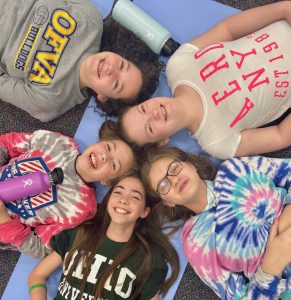Yoga for Children
It’s often assumed that one must already be flexible and physically fit to participate in yoga. One of the many great aspects of yoga is that it can be modified to fit the age, goals and abilities of almost anyone.
Read MoreEmpathy is the heart of a nurturing and supportive environment. Helping children identify their own feelings helps them to recognize and respect the feelings of others. This in turn supports better communication and conflict resolution and build relationships rooted in trust. Increased social awareness and self-regulation builds a sense of community and create a positive classroom culture. Get your students up and out of their seats for a fun physical activity break that also helps them strengthen their social emotional skills.
Circle time, no matter the age group, is an opportunity for children to socialize and further develop their social emotional learning skills. This practice create a space where students feel empowered to listen and share, build relationships with peers and identify how to appropriately express themselves and relate to others. Circle up and start the day or take a mid-day break with one of these activities and explore empathy through physical activity.
In My Shoes
I feel happy today because I get to see all of my friends.
I feel nervous today because of an upcoming test.
I talked with a friend about how I was feeling.
Talk with students about the similarities and differences they share with their fellow classmates. Discuss the importance of recognizing others experiences and emotions and explore ways to connect and build healthy conversations.
Feelings Charades
Dive deeper with a conversation around different situations associated with each feeling and strategies for managing ones that are more challenging.
Find more playful ideas for exploring empathy, social emotional skills and more in the free downloadable Playworks Social Emotional Learning (SEL) Game Guide.
Activities such as these help children explore…
Get in the routine of doing a daily check-in with students. Create a space where students feel safe to share their emotions as they need.
Be aware that children express emotions differently and some may not want to share how they are feeling and that is okay. Offer opportunities in the classroom for children to decompress or self-select activities that support emotional regulation.
Engage parents in the social emotional learning. Share with them the activities or lessons happening in the classroom and offer tips for replicating or continuing the learning at home. Better yet – integrate mindful practices into parent teacher conferences or other events so everyone can participate together.
Connect with your community and explore opportunities for local instructors to teach a creative movement or yoga session. Take pictures of students learning different poses and create easy flash cards students can take home and practice with their families.
For more activities and ideas like this one, be sure to sign up for our news and updates. And if you like what you see, please donate to support our work creating more ways to help build a healthier future for kids.
Categories: Physical Activity & Play, Social-Emotional Health, At Home, At School, Digital Resource